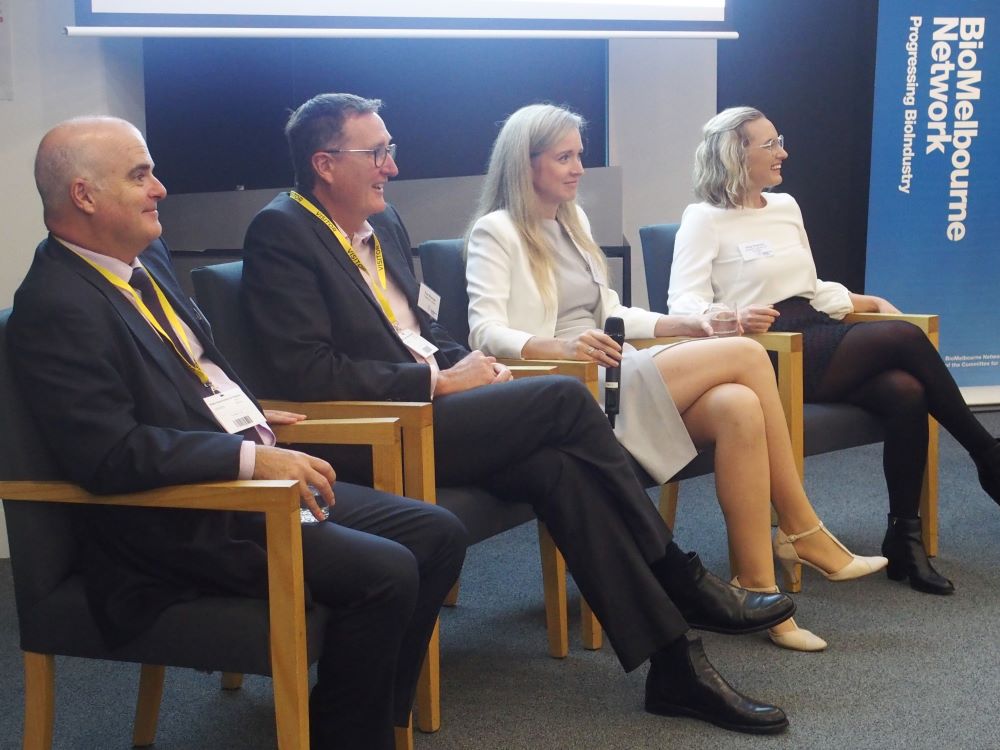12 March 2020
On Thursday 5th March 2020 BioMelbourne Network held their 8th Annual Devices + Diagnostics Lab, addressing the theme of Manufacturing, Markets and Minefields in the medical technology sector. Over 160 industry professionals spent the day discussing the development of new medical technologies in the era of Industry 4.0 and exploring the challenges of this with colleagues and new connections.
Andrew Wear, Director of Innovation for the Victorian Government Department of Jobs, Precincts and Regions opened the day by highlighting the importance of medical and health technology to the Victorian economy and the enormous growth of the sector in recent years. With medical devices generating greater than $129 million in exports and more than $21 billion from the biomedical technologies sector supporting the Australian economy annually, there is no sign that this growth will be slowing down.

L – R: John Sharman, Medical Developments International, Paul Brennan, PolyNovo Ltd, Dr Ewa Douroux, Leica Biosystems & Shay Chalmers, Strategic Engineering Australia.
Formalities began with a session discussing the current manufacturing landscape, in particular the impact of Industry 4.0 on the current medical technology industry. For every company and industry, this fourth industrial revolution “means something different” (Bradley Trewin, Bosch Australia) and is not “just about devices or diagnostics – it’s about people” (Dr Sean Gallagher, Swinburne). Our speakers in this session spoke broadly to topics encompassing the future workplace and changing the current roles of humans in the workplace, training the next generation of innovators and encompassing and celebrating diversity in the medtech workplace. Key learnings included the important distinction between work and learning, how digital technologies are changing the way Australians work, and creating value in your business. According to Dr Sean Gallagher (Swinburne), the digital age is defined by three fundamental factors – the pace of change, interdependencies and connectivity, and the constant need to be evolving (PIE). Dr Jason Coonan (IMCRC) shared a key theme for the day – that we must “collaborate to innovate” – including creating partnerships between universities and research institutes, government, industry associations, and each other.
The second session focused on the current medical technology markets, featuring four expert speakers from leading companies of successful start-ups. Commonalities between companies of all sizes were discussed, including adaptability of designs, material availability and risk mitigation. From the start-up perspective, Paul Brennan (PolyNovo Ltd) stressed the need for a “unique product” and shared key tips for both the beginning of the start-up journey and when expanding. A panel discussion examined common mistakes in the early stages of medtech and healthtech development – including progressing too quickly, underestimating costs, lack of transitional staff, and change management and lack of quality or regulatory management. The need for cultural awareness and diversity both within a company and when expanding was again a common topic across presentations, with Paul Brennan reminding us that “your business is only as good as your talent”. Dr Ewa Douroux (Leica Bio) also stressed the implementation of environmental initiatives and encouraged attendees (and their suppliers and partners) to opt for more environmentally conscious options.
Mistakes and lessons learnt in Session 2 transitioned into the Minefields theme, where speakers provided an in-depth view into the development and inner workings of established medtech and healthtech companies. David James (Scinogy) provided a fantastic example of startup success – though they only have three employees and no office, they are a global company with extensive partnerships. The secret ingredient? Sisu – a Finnish word David describes as “absolute determination with a potential recklessness”. Stuart Elliot (Planet Innovation) provided real-life examples of commercialisation challenges completely beyond a company’s control – including regulatory delays, supply chain issues, clinical trial delays and IP theft – and stressed that “the destination you end up at is often in a completely different spot than you thought”. A common theme across all presentations was forming strategic partnerships – alignments which are “shared risk, shared reward”.
The day concluded with an esteemed panel making sense of the Manufacturing, Markets and Minefields discussed throughout the day. COVID-19 was a hot topic, with speakers providing their thoughts on the current impact of the virus on the medical and health technology sectors. Risk mitigation with supply chains was again raised, as many medtech companies often have a sole component supplier. Lusia Guthrie (BioMelbourne Network) compared this to the pharma industry – where multiple supply chains are required. This is a greater problem with international sourcing (particularly currently with COVID-19) – but local manufacturing in Australia can be expensive. Stuart Elliot (Planet Innovation) and Biju Kishor (SeerPharma) suggest reducing costs by smart and bulk import of materials, and clever product design that utilises materials and decreases labour. As Lusia Guthrie elegantly closes, COVID-19 has highlighted “how connected we all are”.



